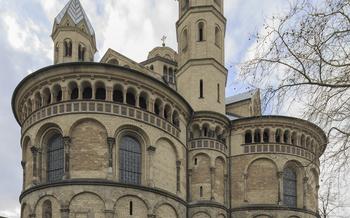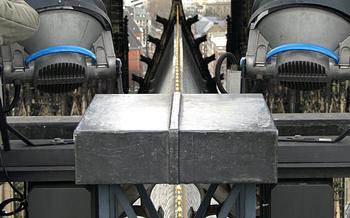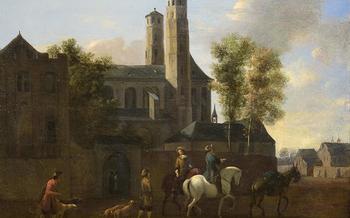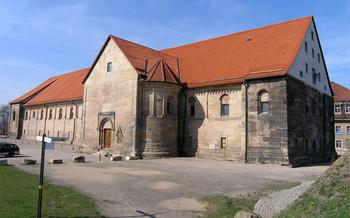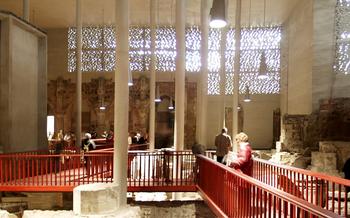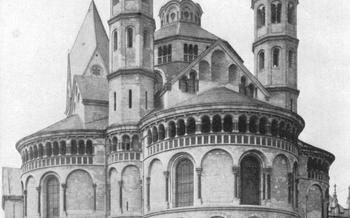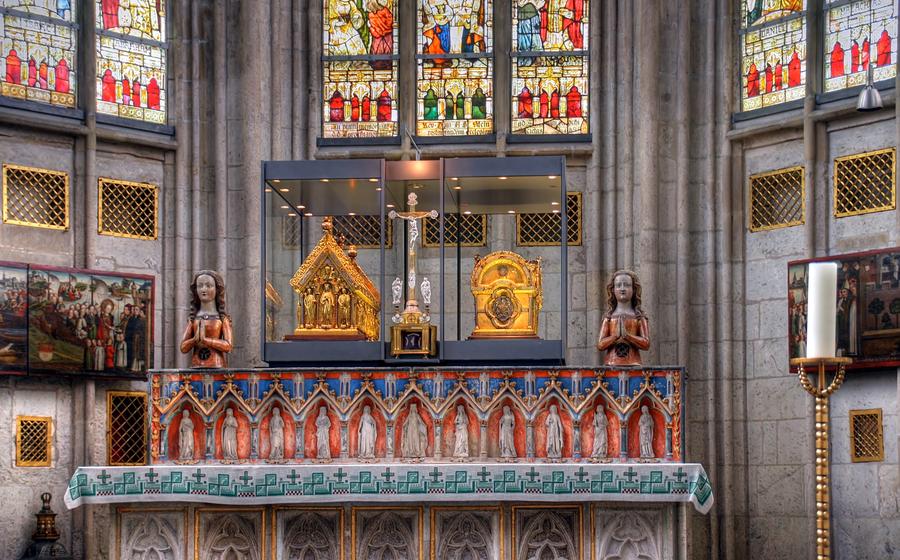
St. Ursula
- History of the Church
- The Architecture
- The Relics
- The Treasury
- The Stained Glass Windows
- The Altars
- The Statues
- The Frescoes
- The Crypt
- Guided Tours
- Getting There
- Admission Fees
History of the Church
The history of St. Ursula's Church is a long and storied one. The first church on this site was built in the Romanesque style in the 10th century. This church was destroyed by fire in the 12th century, and the current Gothic church was built in its place. The Gothic church was expanded and renovated several times over the centuries, including a major Baroque renovation in the 17th century.
The Romanesque church was a simple, single-nave building with a square tower. The Gothic church was much larger and more elaborate, with a nave, two aisles, and a choir. The Baroque renovation added a new facade, a new choir, and a new sacristy. The church was also decorated with new sculptures, paintings, and stained glass windows.
Today, St. Ursula's Church is one of the most important Gothic churches in Germany. It is also one of the most popular tourist attractions in Cologne, and it is a UNESCO World Heritage Site.
The Architecture
The Church of St. Ursula is a masterpiece of Gothic and Romanesque architecture. The Romanesque elements, dating back to the 11th century, can be seen in the heavy stone walls, the rounded arches, and the sturdy towers. The Gothic additions, made in the 13th and 14th centuries, include the pointed arches, the vaulted ceilings, and the delicate tracery of the windows.
The exterior of the church is equally impressive. The massive towers, the intricate carvings, and the stunning stained-glass windows create a breathtaking sight. The interior is even more awe-inspiring. The soaring vaults, the delicate columns, and the beautiful artwork create an atmosphere of awe and wonder.
One of the most unique features of the church is its double-choir design. This means that the church has two choirs, one at the east end and one at the west end. This design was intended to accommodate the large number of pilgrims who came to visit the church in the Middle Ages.
The Relics
The Church of St. Ursula is home to a remarkable collection of relics, including the bones of Saint Ursula herself and the skulls of the 11,000 virgins. These relics are of great significance to the Catholic Church, and they attract pilgrims from all over the world.
The bones of Saint Ursula are enshrined in a golden reliquary, which is located in the center of the church. The reliquary is decorated with precious stones and jewels, and it is a testament to the saint's importance. The skulls of the 11,000 virgins are displayed in a glass case, which is located in the crypt of the church. The skulls are arranged in rows, and they are a reminder of the terrible persecution that the early Christians endured.
The relics of Saint Ursula and the 11,000 virgins are a powerful reminder of the faith and courage of the early Christians. They are a source of inspiration for pilgrims from all over the world, and they are a testament to the enduring power of the Christian faith.
The Treasury
The St. Ursula Church in Cologne boasts a treasury that houses a remarkable collection of religious artifacts. This treasury is a testament to the church's rich history and enduring significance as a center of Christian devotion.
Among the highlights of the treasury is the Golden Shrine of the Three Magi, a magnificent piece of goldsmith work dating back to the 12th century. The shrine is adorned with intricate carvings and precious stones, and it is believed to contain the relics of the Three Wise Men who visited the infant Jesus. Another notable item in the treasury is the Reliquary of Saint Ursula, a silver-gilt reliquary that contains the bones of the saint. The reliquary is beautifully decorated with enamel and gemstones, and it is a testament to the veneration of Saint Ursula in Cologne.
In addition to these major pieces, the treasury also contains a variety of other valuable objects, including chalices, monstrances, and processional crosses. These objects are made from a variety of materials, including gold, silver, and ivory, and they are all exquisitely crafted. The treasury of St. Ursula Church is a must-see for anyone interested in religious art and history.
The Stained Glass Windows
The stained glass windows of St. Ursula's Church are breathtaking works of art that add to the church's overall splendor. They depict scenes from the Bible, the lives of the saints, and the history of the church. The oldest windows date back to the 13th century, while the most recent ones were installed in the 19th century.
The beauty of the windows lies in their rich colors and intricate designs. The stories depicted in the windows are engaging and thought-provoking, inviting visitors to contemplate the events of the past.
The windows have also survived numerous challenges over the centuries, including wars, fires, and natural disasters. Their restoration and preservation are a testament to the dedication of the church's caretakers and the importance of these windows as historical and artistic treasures.
The Altars
The main altar, located in the center of the apse, is a stunning masterpiece of Baroque art. It features a large painting depicting the martyrdom of Saint Ursula, surrounded by intricate carvings and sculptures. The side altars, located along the side walls of the church, are also adorned with beautiful paintings and carvings, each depicting a different scene from the life of Saint Ursula and her companions.
The symbolism of the altars is rich and complex. The main altar represents the triumph of faith over death, while the side altars represent the virtues of the saints and the rewards of heaven. The altars are a reminder of the sacrifices made by the early Christians and the hope that they held for eternal life.
The Statues
The church of St. Ursula is home to a remarkable collection of statues, each with its own unique story to tell. The most famous statue is the golden figure of Saint Ursula herself, which stands proudly above the high altar. The statue is adorned with exquisite detail, from the intricate folds of her gown to the delicate expression on her face.
In addition to the statue of Saint Ursula, the church also houses numerous statues of other saints and martyrs, including Saint Cordula, Saint Agnes, and Saint Catherine. These statues are scattered throughout the church, adding to its overall sense of grandeur and devotion.
One of the most striking things about the statues in St. Ursula's is their diversity. There are statues carved from wood, stone, and metal, and each one has its own unique style and expression. This diversity reflects the rich history of the church and the many different artists who have contributed to its decoration.
The statues in St. Ursula's are not just works of art; they are also objects of devotion. For centuries, pilgrims have come to the church to pray to the saints and ask for their intercession. The statues serve as a reminder of the power of faith and the enduring legacy of the martyrs who gave their lives for their beliefs.
The Frescoes
The walls of the St. Ursula Church are adorned with vibrant and captivating frescoes that depict scenes from the life of Saint Ursula and her companions, as well as other biblical stories. Created by talented artists over several centuries, these frescoes are not only visually stunning but also hold great historical and religious significance.
One of the most notable frescoes is located in the apse of the church and depicts the martyrdom of Saint Ursula and her companions. The scene is rendered in vivid colors and intricate detail, capturing the emotions and expressions of the figures as they face their tragic fate. Other frescoes depict scenes such as the arrival of Saint Ursula and her companions in Cologne, their encounter with the Huns, and their eventual martyrdom.
In addition to the scenes from the life of Saint Ursula, the frescoes in the church also depict various biblical stories, such as the creation of the world, the expulsion of Adam and Eve from Paradise, and the life of Jesus Christ. These frescoes serve as a visual representation of the church's teachings and provide a glimpse into the beliefs and values of the Christian community in Cologne throughout the centuries.
The frescoes in the St. Ursula Church are not only artistic masterpieces but also valuable historical documents that offer insights into the lives and beliefs of the people of Cologne in the past. They are a testament to the enduring power of art and its ability to convey stories and messages across time.
The Crypt
Beneath the church lies the dark and mysterious crypt, a chilling reminder of the church's macabre history. Descend the worn stone steps into the dimly lit chamber, your footsteps echoing eerily through the vaulted ceilings. Here, in this subterranean realm, rest the remains of the martyred virgins, their bones arranged in neat rows, a testament to their unwavering faith. The air hangs heavy with a palpable sense of reverence and sorrow, as if the walls themselves hold the whispered prayers and pleas of those who perished long ago.
The crypt is a stark contrast to the vibrant splendor of the church above, its simplicity and austerity serving as a poignant reminder of the sacrifices made by these young women. As you wander among the skeletal remains, you can't help but feel a profound connection to their story, a connection that transcends time and space. The crypt is a place of contemplation and reflection, a place where the past and present intertwine, reminding us of the enduring power of faith and the fragility of life.
Guided Tours
St. Ursula is a popular tourist destination, and guided tours are available to help visitors make the most of their visit. Tours are offered in a variety of languages, including English, German, French, and Spanish. The cost of a tour is typically around 10 euros, and discounts are available for students and seniors. Tours last for about an hour and cover the history, architecture, and relics of the church.
Guided tours are a great way to learn more about the fascinating history of St. Ursula and to see the church's many highlights up close. Visitors can ask questions and get personalized insights from the knowledgeable tour guides. Tours are available at regular intervals throughout the day, and reservations can be made in advance or on the spot.
Whether you are a history buff, a lover of architecture, or simply someone who appreciates beautiful things, a guided tour of St. Ursula is a must-do experience.
Getting There
St. Ursula is conveniently located in the heart of Cologne, making it easily accessible by foot or public transportation. For those arriving by car, there are several parking garages nearby, such as the Domparkhaus or the Rheinparkhaus.
If you prefer to use public transportation, you can take the U-Bahn (subway) to the Dom/Hauptbahnhof station or the Neumarkt station. From there, it is just a short walk to the church.
Several bus lines also stop near St. Ursula, including the 132, 133, 136, and 14You can find the bus stop schedules and routes on the KVB (Cologne Public Transportation Company) website.
Admission Fees
Visiting the St. Ursula Church is free of charge, allowing everyone to experience its beauty and significance without financial barriers. However, donations are gratefully accepted to support the ongoing preservation and maintenance of this historic landmark. Additionally, guided tours are available for a small fee, offering a deeper dive into the church's history, architecture, and religious significance. These tours are led by knowledgeable guides who provide insightful commentary and answer any questions visitors may have.
